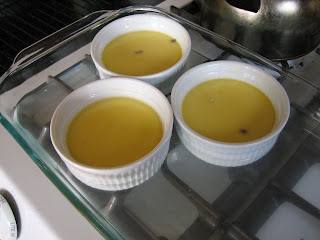
I know I kvetch a lot about the dreary repetition of certain vegetables from my CSA, but every now and then, there's a brand new vegetable I've never tasted before which makes the whole investment worthwhile. After all, it was this CSA that introduced me to the deliciousness of
garlic scapes in our very first delivery from them last year. I now anxiously look forward to the beginning of the CSA season for the few weeks that we get these curly, green miracles that are so delicious on pizza or even substituted for onion and garlic in guacamole.
But I digress. The week we got the kohlrabi was just such an occasion, perhaps appreciated all the more as they sat amongst a delivery of peas, green beans, and squash. I'd never tasted, let alone seen, a kohlrabi before so when we got the packing list at the beginning of the week, I
researched what they were and put out a call for help as a Facebook status. I only got two responses, both from in-laws, but they were very helpful, although polar opposites. One suggested roasting, the other suggested eating raw with generous helpings of sea salt. Since both John and I were kohlrabi virgins, if you will, I decided to give both methods a try so we could maximize our umm... kohlrabi experience, get a sense of how the vegetable's taste changes as it cooks and what may be the method of choice for future kohlrabi dalliances.

In this post, I'll describe the roasted kohlrabi dish. I love roasted vegetables, that nutty flavor complemented by a slightly crisp edge to the vegetables. I particularly like vegetables that have roasted with some chicken since the vegetables get mixed with the juices and fat from the bird. I didn't feel like dealing with a whole chicken though, so I took advantage of an Amazon Fresh sale of 2 6oz chicken breasts with drummettes. Unfortunately, I was sadly mistaken since I assumed that the chicken would still be bone in, so to accommodate the length of cooking time for roasting the vegetables and prevent the chicken from drying out, I ended up wrapping the chicken with prosciutto, hoping that the outside hammy layer would keep the chicken moist while crisping up on the outside.
Once prosciutto was involved, I got inspired by saltimbocca dishes and decided to incorporate some sage. Fooled again-- the fresh sage bush which I had relied upon existing in my yard somewhere had apparently died when John moved it to a new spot to make room in the vegetable garden. I had to make do with dried sage, and I think that this could have been better with fresh. Rounding out the Italian inspired flavors was some fennel mixed in with the kohlrabi and mushrooms, which acted as a bed upon which the wrapped chicken sat.
The kohlrabi was sweet and nutty when roasted. The fennel's delicious anise flavor was a contrasting flavor spike and everything was mellowed by the earthiness of the mushrooms. Overall, this worked out to be a delicious one pot meal, but here are some things to keep in mind should I do this again: 1) trim the kohlrabi better as roasting wedges of the vegetable sometimes had a tough, chewy skin attached. Perhaps
this may be enlightening (from one of the blogs I regularly follow); and 2) maybe don't bother wrapping the chicken with prosciutto since the result was soggy skin and I'd take crispy chicken skin over prosciutto wrapped, but soggy any day.

2 kohlrabi, cut into 1 inch wedges
8 oz cremini mushrooms, halved
1 small fennel bulb, sliced
2 6oz chicken breasts, skin on
2 pieces of prosciutto
2 tbsp unsalted butter, softened
1 tsp dried sage
1/2 tsp salt
1/4 tsp pepper
1 package fresh linguini
1-2 tbsp olive oil
salt/pepper to taste
Preheat oven to 400 degrees. In a roasting pan, mix together the kohlrabi, mushrooms, and fennel with olive oil and salt and pepper. Put in the oven to get a head start on roasting.
In the meantime, mix together the butter, sage, 1/2 tsp salt, and 1/4 tsp pepper. Carefully pull back the skin from the chicken and smear about 1 tsp of the butter mix all over the chicken meat and on the skin. Wrap each chicken in 1 piece of prosciutto. Set on top of your roasting vegetables and let continue to cook for another 20 minutes or until a meat thermometer says that the interior of the chicken has reached 160 degrees F.
Cook pasta according to directions, drain, and mix with remaining butter mix. Plate by putting a pile of pasta on the plate, topped with a chicken breast with some of the roasted vegetable mix on the side.
CSA Count: 2
Kohlrabi, fennel





 I can't say enough how much I love creme brulee. I love the copper brown sugar crust that looks like stained glass and love even more the cool, silky texture of the custard below. Amelie definitely got it right: taking that first crack at the sugar surface is such a simple pleasure and the moment should be savored.
I can't say enough how much I love creme brulee. I love the copper brown sugar crust that looks like stained glass and love even more the cool, silky texture of the custard below. Amelie definitely got it right: taking that first crack at the sugar surface is such a simple pleasure and the moment should be savored.


